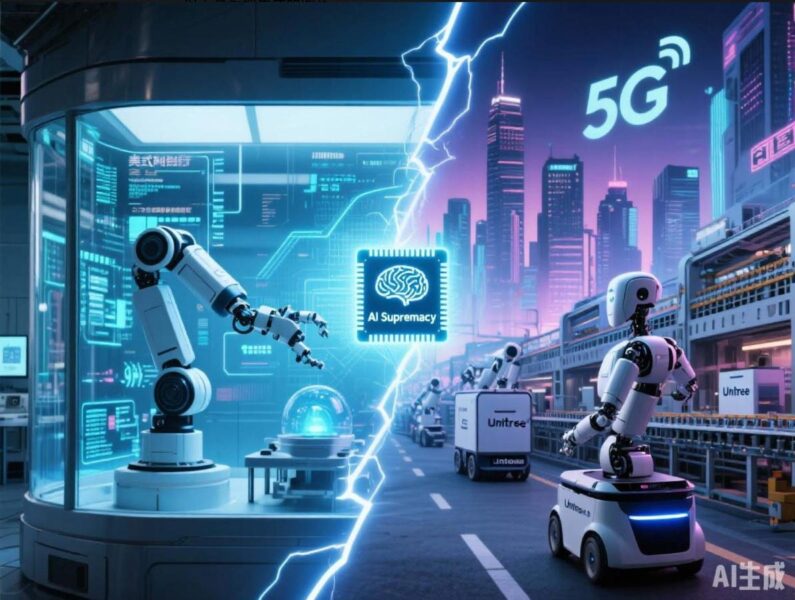A Comparison of Future EmbodiedRobots in the East and West (Generated by Tencent Yuanbao)
Author
The race to build the world’s first functional humanoid robots is no longer just a contest of hardware. It’s a high-stakes battle over two radically different philosophies of development, the crux of which is the robots’ ‘brain’. In one corner U.S. tech giants like Google and Meta take a research-heavy approach, road-testing robots in controlled, simulated environments before putting them to market.
In the other corner, China is deploying robots in the real world at an increasingly rapid pace. Powered by companies like Agibot and Unitree, their strategy is to push robots out of labs, into factories, streets, and homes, developing the robotic brain by learning on the job. This bold strategy relies on an increasingly open-source approach – one that is putting China at the sharp edge of the competition.
The Chinese Strategy: Learn by Doing
The Chinese approach to embodied AI is deploy now, iterate fast. Rather than wait for a perfect, all-in-one humanoid robot, the nation’s tech leaders are saturating the market with task-specific robots to rapidly gather real-world data. Companies like Unitree and JD.com aren’t just selling robots. They’re strategically deploying them in logistics, retail, and public safety to create a massive, living laboratory.
According to the International Federation of Robotics, in 2023 China deployed 276,288 new robots. That same year the U.S. deployed only 55,389. Every interaction, every navigation challenge, and every data point these robots capture feeds back into their AI models, allowing for unparalleled, real-time refinement.
This learn-on-the-job philosophy is epitomised by Agibot’s Lingqu OS. Described as the “Android for robots” Agibot’s open-source operating system is designed to lower the barrier to entry for developers and manufacturers, fostering a collaborative ecosystem.
It is a brilliant play: by democratising the software layer, China encourages a diverse range of companies to build and deploy robots, collectively generating the colossal datasets necessary to train the next generation of embodied AI. The ultimate goal is not to create a single dominant robot but to build the foundational data engine for the entire industry, positioning China at the forefront of the global race for AI supremacy.
The American Strategy: Perfecting the Lab
The United States has staked its humanoid robot ambitions on a strategy of deliberate control: build intelligence first, deploy later. This philosophy reflects a broader American tradition in frontier technologies – prioritising precision and intellectual property over speed. While China is flooding its streets and factories with imperfect machines, U.S. firms are doubling down on the lab.
Meta’s Habitat platform typifies this approach. It isn’t a product meant to roam factory floors but a massive simulation environment designed to train robots in abstract reasoning, spatial awareness and decision-making under controlled conditions.
The logic is straightforward: solve the hardest problems in silico, then release robots that enter the world already equipped with sophisticated cognitive capabilities. By insulating machines from the messy unpredictability of real life, American researchers hope to avoid failures that could derail public trust or cost them money.
At the other end of the spectrum lies Google, whose closed-system model reflects a different but equally cautious impulse. Rather than leaning into open collaboration, Google emphasises proprietary control. Keeping its research tightly held, Google bets that closed ecosystems will yield long-term strategic advantage. Both paths converge on the same principle: avoid premature deployment and retain command over the ‘brain’ of the machine.
This approach carries clear benefits in terms of reliability and safety. But it also exposes the U.S. to a potential disadvantage: while its robots are learning in virtual laboratories, China’s are accumulating vast quantities of real-world data. In the race to define humanoid intelligence, America’s careful pace may prove either visionary or fatally slow.
The Fork in the Road: Two Futures for Robotics
The global contest over humanoid robotics has crystallised into a stark choice between two visions. On one side, China advances with a move-fast-and-break-things ethos, deploying robots widely in factories, warehouses, and public spaces. Each imperfect deployment generates data, feeding a shared ecosystem where open-source code and iterative improvement drive rapid progress. This is the open field model: chaotic, sprawling, but rich with collective experimentation.
The United States, by contrast, pursues a walled garden approach. Companies like Meta and Google are intent on solving intelligence under tightly controlled conditions, perfecting algorithms in simulation before release. This model promises more reliable robots and maintains proprietary control over breakthroughs, but it risks isolation. Without exposure to the unpredictability of real-world environments, U.S. systems may emerge elegant in theory but brittle in practice.
The core conflict is not merely technological but philosophical: should embodied AI evolve through the messy, distributed learning of deployment, or through carefully staged advances behind corporate walls? Whichever path prevails will determine the pace, distribution, and even the ethics of humanoid adoption. The fork in the road is clear. What, for now, remains unclear is which route results in global leadership.
What’s Next?
The race to build humanoid robots is less about today’s prototypes than about the ecosystems shaping their evolution. China wagers on the power of scale and openness, trusting that imperfect machines in the real world will generate the data to drive exponential progress. The United States, in contrast, seeks to refine intelligence behind closed doors, betting that precision and control will ultimately win out.
The true question is not whether robots will walk among us, but under which philosophy they will learn to think. Can a walled garden outlast an open field, or will openness inevitably prevail?









